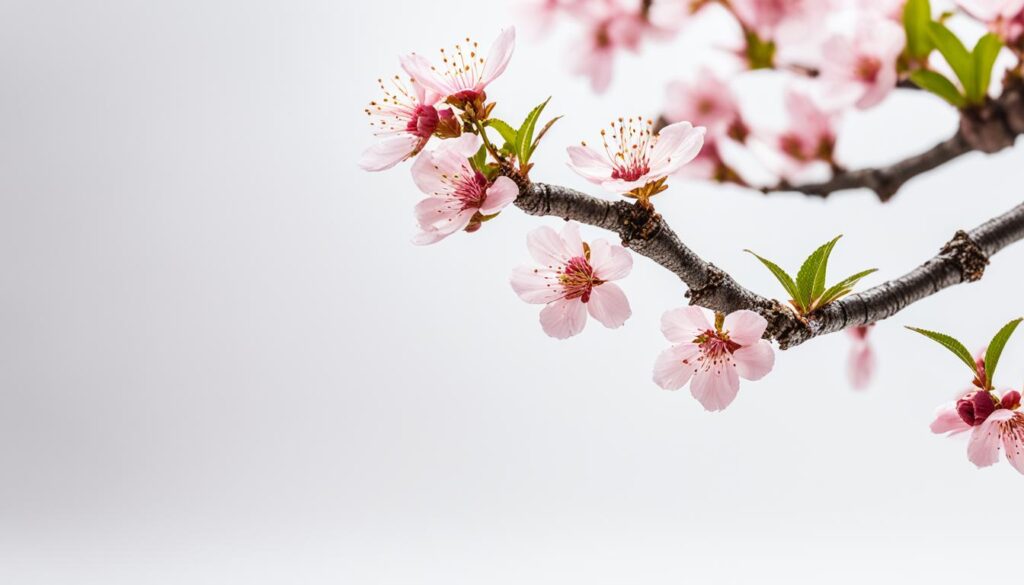The captivating bonsai tree cherry blossom, also known as the Sakura Bonsai, holds a unique and cherished place in the world of bonsai cultivation. These miniature marvels, with their stunning blossoms and delicate foliage, have long been a favorite among both seasoned bonsai enthusiasts and amateur growers alike.
Cherry or Prunus Bonsai, with their resilience and adaptability, lend themselves beautifully to the art of bonsai. From the placement and watering requirements to the intricate techniques of pruning, wiring, and repotting, mastering the cultivation and care of these captivating trees is a journey that rewards the dedicated bonsai practitioner with a living work of art.
Beyond their visual splendor, the bonsai tree cherry blossom holds deep cultural significance, particularly in Japan, where the Sakura has been revered for centuries. Understanding the origins, varieties, and historical significance of these miniature marvels enhances the appreciation and understanding of this timeless horticultural practice.
Key Takeaways
- The bonsai tree cherry blossom, or Sakura Bonsai, is a cherished and captivating addition to the world of bonsai cultivation.
- Cherry or Prunus Bonsai are known for their resilience, adaptability, and stunning blooms, making them a favorite among enthusiasts.
- Mastering the cultivation and care of bonsai cherry blossoms involves a deep understanding of their specific needs, from placement and watering to pruning and wiring.
- The Sakura Bonsai holds deep cultural significance in Japan, reflecting centuries of tradition and appreciation for the beauty and ephemeral nature of the cherry blossom.
- Growing and shaping a thriving bonsai cherry blossom can be a rewarding experience for both seasoned practitioners and those new to the art of bonsai.
The History of Sakura Bonsai
Sakura bonsai, or cherry blossom bonsai, hold a significant place in the history of bonsai art, reflecting centuries of tradition and cultural importance, particularly in Japan. The practice of bonsai, which originated in China over a thousand years ago, was later adopted and refined by the Japanese. The sakura, or cherry blossom, has been a beloved symbol in Japanese culture for many centuries, representing the beauty and ephemeral nature of life.
Origins and Cultural Significance
The history of bonsai dates back over a thousand years to China, where it was known as “penjing.” Bonsai cultivation originated in China and was later refined by the Japanese, becoming an integral part of Japan’s cultural and artistic heritage. The sakura, or cherry blossom, has been a beloved symbol in Japanese culture for many centuries, symbolizing renewal, fleeting beauty, and the impermanence of life. The Japanese tradition of “hanami” involves picnicking under cherry blossoms, reflecting the cultural significance of these delicate flowers.
Varieties Suitable for Bonsai
The most popular varieties for bonsai include Prunus serrulata (Japanese Cherry) and Prunus incisa (Fuji Cherry), which are favored for their resilience, adaptability, and distinctive flowering patterns. Sakura bonsai are particularly popular for their stunning floral displays, with the cherry blossom, with its delicate pink and white flowers, symbolizing renewal and the fleeting nature of beauty.
Selecting Your Cherry Blossom Bonsai
Choosing the right cherry blossom bonsai involves several key considerations, including the size, age, and health of the tree. Younger bonsai trees may be more affordable and adaptable, while older trees offer a more developed and established bonsai specimen.
Size, Age, and Health Considerations
When selecting a bonsai, pay close attention to the tree’s size, age, and overall health. Younger trees may require more training and care, but they can be more responsive to shaping and grow into beautiful bonsai over time. Older, more established bonsai trees often come with a higher price tag but can provide a mature, refined appearance right away.
Where to Purchase
Prospective bonsai buyers have several options when it comes to purchasing a cherry blossom bonsai. Local bonsai nurseries allow you to inspect the tree in person and get personalized guidance, while online bonsai retailers offer a wider selection but less hands-on support. Carefully consider the advantages of each purchasing method to find the bonsai that best suits your needs.
Beginner-Friendly Varieties
For those new to bonsai cultivation, the Prunus incisa ‘Kojo-no-mai’ and Prunus serrulata ‘Kanzan’ varieties are excellent choices due to their resilience and adaptability. These cherry blossom bonsai varieties are known for their hardiness and ease of care, making them great options for beginners to explore the art of bonsai with confidence.
Sunlight and Temperature Needs for Sakura Bonsai

Proper sunlight and temperature are crucial for the health and flowering of Sakura bonsai. They require ample bonsai light requirements, about 5-6 hours of direct light daily, with some shade during the hottest part of the day. Cherry blossom bonsai prefer cooler conditions, with temperatures ranging from 15°C to 25°C (59°F to 77°F) during the growing season, and 0°C to 10°C (32°F to 50°F) in the winter to ensure a rest period. Adjusting the exposure and protection of the bonsai throughout the bonsai seasonal care is key to maintaining its health and enhancing its blooming potential.
Ideal Growth Conditions
Sakura bonsai require about 5-6 hours of direct sunlight daily for healthy growth and blooming. During summer, providing some shade during the hottest part of the day can prevent leaf burn.
Temperature Considerations
Ideal temperatures for bonsai temperature range between 15°C to 25°C (59°F to 77°F) during the growing season. In winter, temperatures around 0°C to 10°C (32°F to 50°F) are needed for a rest period and profuse blooming in spring.
Seasonal Adjustment Tips
Adjusting the exposure and protection of the bonsai throughout the seasons is key to maintaining its health and enhancing its blooming potential. Providing the right bonsai temperature and bonsai light requirements for each stage of the plant’s growth cycle is essential for the overall well-being and performance of your Sakura bonsai.
Watering Your Cherry Blossom Bonsai
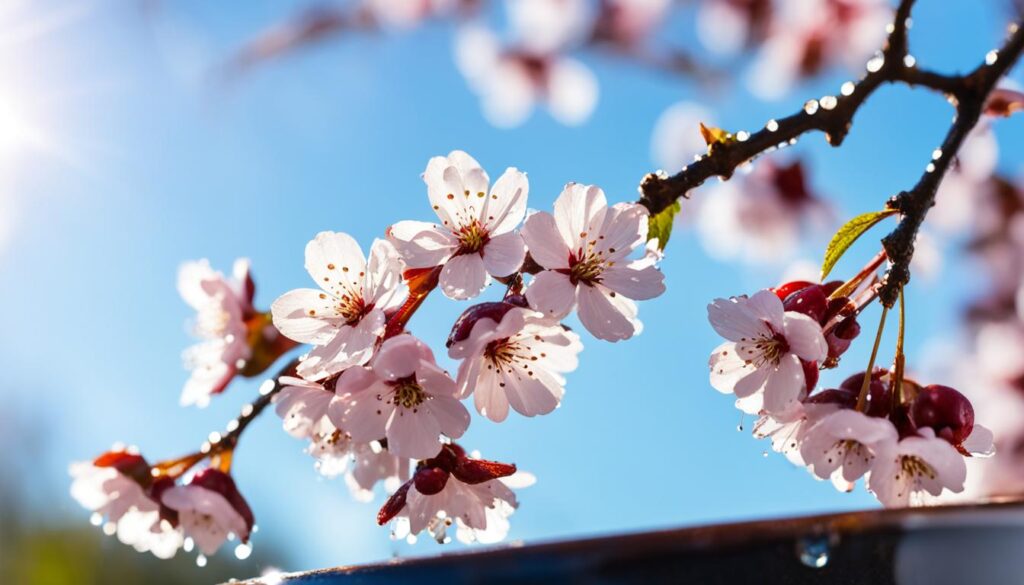
Watering is critical for the health of your bonsai watering Cherry Blossom Bonsai. The frequency and quantity of water should be adjusted based on factors like the size of the bonsai, pot, soil, and environmental conditions. Water thoroughly, allowing water to run out of the drainage holes, when the topsoil feels slightly dry. Bonsai over-watering can lead to root rot, while bonsai under-watering will cause leaves to dry out and wilt. Consistent and appropriate watering, along with using a well-draining soil mix, is essential for maintaining the right bonsai moisture balance for your bonsai.
Frequency and Quantity Guidelines
The bonsai watering frequency for Cherry Blossom Bonsai can vary depending on factors like pot size, soil type, and environmental conditions. As a general guideline, water the bonsai thoroughly when the topsoil feels slightly dry to the touch, allowing the water to drain out of the bottom of the pot. Avoid letting the rootball dry out completely, as this can lead to stress and potential damage to the tree.
Identifying Watering Issues
Monitoring your bonsai’s bonsai moisture levels is crucial to prevent both bonsai over-watering and bonsai under-watering. Signs of over-watering include leaf yellowing, wilting, and potential root rot. Conversely, under-watering will cause the leaves to dry out and wilt. Adjust your watering frequency and quantity accordingly to maintain the optimal bonsai moisture level for your Cherry Blossom Bonsai.
Moisture Maintenance Best Practices
To ensure the proper bonsai moisture levels for your Cherry Blossom Bonsai, consider the following best practices: Use a well-draining bonsai soil mix, check the soil moisture daily, and adjust watering based on factors like temperature, humidity, and the bonsai’s location. Avoid letting the soil become completely dry or overly saturated, as either extreme can be detrimental to the health of your bonsai.
Wiring Your Sakura Bonsai
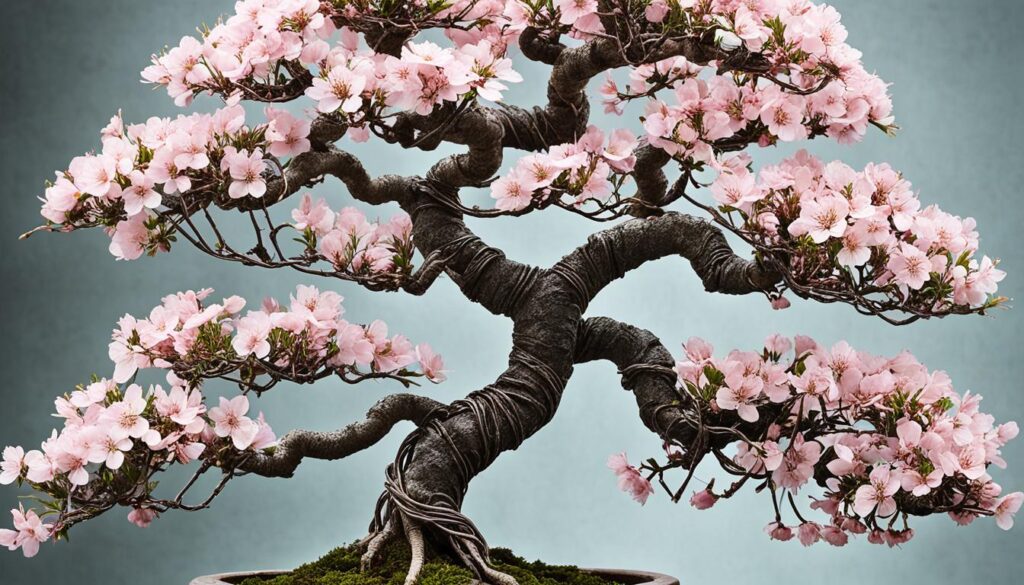
Mastering the art of bonsai wiring is a crucial step in shaping and directing the growth of your Sakura Bonsai. This pivotal technique allows you to train the tree to grow in a specific direction or form, ultimately enhancing the visual appeal and artistic expression of your miniature cherry blossom masterpiece.
Purpose and Techniques
The primary purpose of bonsai wiring is to guide the branches and trunk of your Sakura Bonsai into the desired shape and structure. Aluminum or copper wire is commonly used for this process, with aluminum being more beginner-friendly due to its pliability, while copper holds its shape better for heavier or stiffer branches.
Step-by-Step Wiring Guide
To wire your Sakura Bonsai, begin by selecting the appropriate wire gauge based on the size and thickness of the branches and trunk. Carefully wrap the wire around the targeted areas, gently bending and shaping the bonsai tree to achieve your desired aesthetic. Take care not to over-tighten the wire, as this can damage the delicate bark and cambium layer. With patience and practice, you’ll master the techniques of bonsai training and bonsai shaping to create a stunning, balanced Sakura Bonsai specimen.
bonsai tree cherry blossom
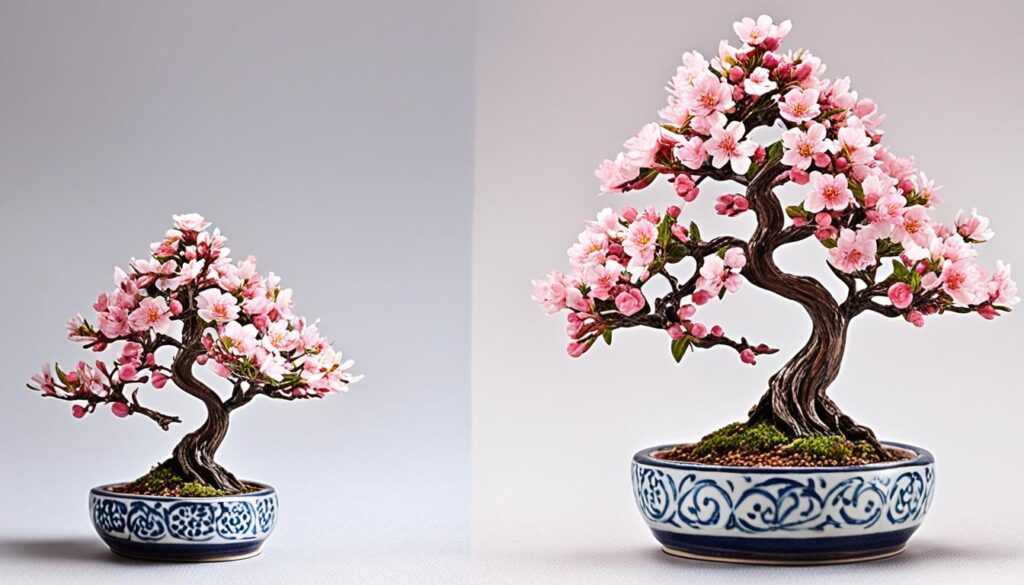
The bonsai tree cherry blossom, also known as the Sakura bonsai, is a captivating and highly sought-after addition to any bonsai enthusiast’s collection. These miniature trees, with their delicate pink blossoms and elegant silhouettes, have long been a symbol of Japanese culture and the beauty of nature. Whether you’re a seasoned bonsai grower or just starting your journey, understanding the unique care requirements of the bonsai tree cherry blossom is essential to cultivating a thriving, visually stunning specimen.
One of the most remarkable aspects of the bonsai tree cherry blossom is its ability to mimic the graceful form and flowering patterns of its larger counterparts. These trees require a cool winter dormancy period of at least three months, during which they enter a state of rest and prepare for the coming growing season. When spring arrives, the bonsai tree cherry blossom bursts forth with a stunning display of delicate pink blooms, captivating all who behold them.
Maintaining the health and vigor of a bonsai tree cherry blossom requires a keen eye and a deep understanding of its unique needs. From ensuring the right balance of sunlight and temperature to providing the appropriate watering and fertilization regimes, each aspect of the bonsai’s care must be carefully considered to ensure its long-term success. By mastering these techniques, bonsai enthusiasts can create and cultivate truly remarkable specimens that showcase the natural beauty and cultural significance of the bonsai tree cherry blossom.
Repotting Cherry Blossom Bonsai Trees
Repotting is an essential part of caring for bonsai repotting. These trees should be repotted every two to three years, with older trees repotted less frequently. Repotting is best done in early spring, before the flowers bloom. When selecting a new pot, consider its height and width in relation to the size of the bonsai, as well as the pot’s design and drainage.
Frequency and Timing
It is recommended to bonsai repotting a bonsai cherry tree every two or three years, and older trees less often, to ensure healthy root growth. Repotting is best performed in early spring, before the flowering period, to minimize stress on the tree and promote optimal growth and development.
Pot Selection Guidelines
When selecting a new pot for your bonsai pot selection, consider factors such as the size and age of your bonsai tree. The pot’s height and width should be proportional to the size of the bonsai, and the pot design should complement the overall aesthetic. Ensure the pot has adequate drainage holes to prevent water logging and root rot.
Repotting Procedure
The bonsai repotting process involves carefully removing the tree from its current pot, pruning the roots, and replanting it in the new pot with fresh, well-draining bonsai soil. This delicate procedure requires patience and attention to detail to ensure the tree’s successful transition to its new container.
Soil and Fertilization for Cherry Blossom Bonsai
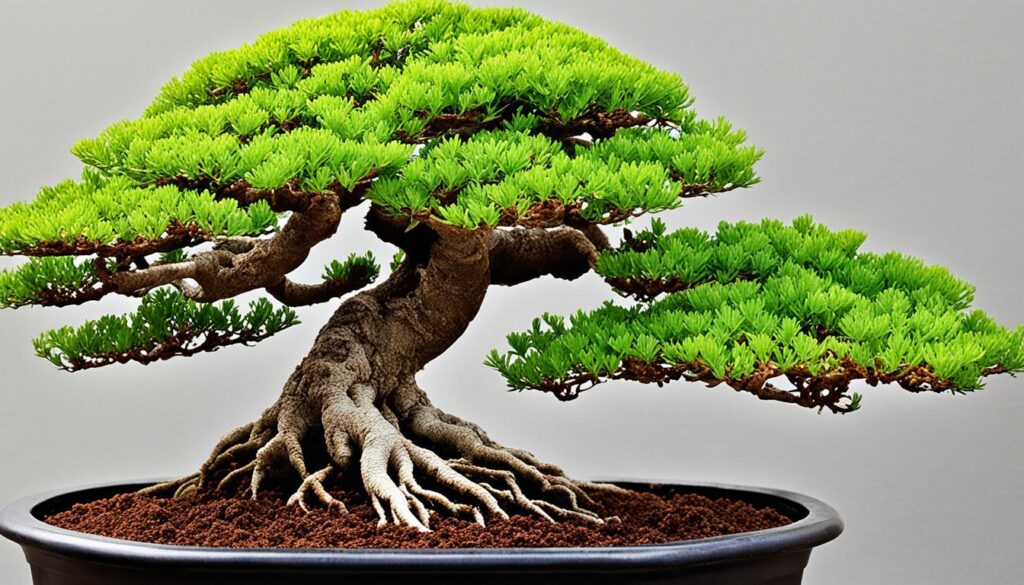
The health and vibrant growth of your Cherry Blossom Bonsai depend greatly on the quality of the bonsai soil and appropriate fertilization. Cherry trees, like other bonsai species, thrive in a well-draining, slightly acidic soil mix with a pH between 5.5 and 6.5.
Appropriate Soil Mix
Commercially available bonsai soil formulas, designed specifically for the needs of bonsai trees, are typically the best choice for your Cherry Blossom Bonsai. These specialized mixes include a blend of components like akadama, pumice, and organic matter that provide excellent drainage and nutrient retention, crucial for the health of your miniature tree.
Fertilizer Needs and Application
Proper fertilization is also essential for the growth and development of your Cherry Blossom Bonsai. Apply a balanced, liquid or solid organic fertilizer monthly during the active growing season, usually from spring to late summer. Older, more established trees may require less frequent fertilization than younger, actively growing specimens. Maintaining a consistent fertilization schedule and adjusting the application frequency as your bonsai matures will ensure optimal bonsai soil pH and nutrient levels for the overall health and vibrant blooming of your Cherry Blossom Bonsai.
Pruning Your Sakura Bonsai
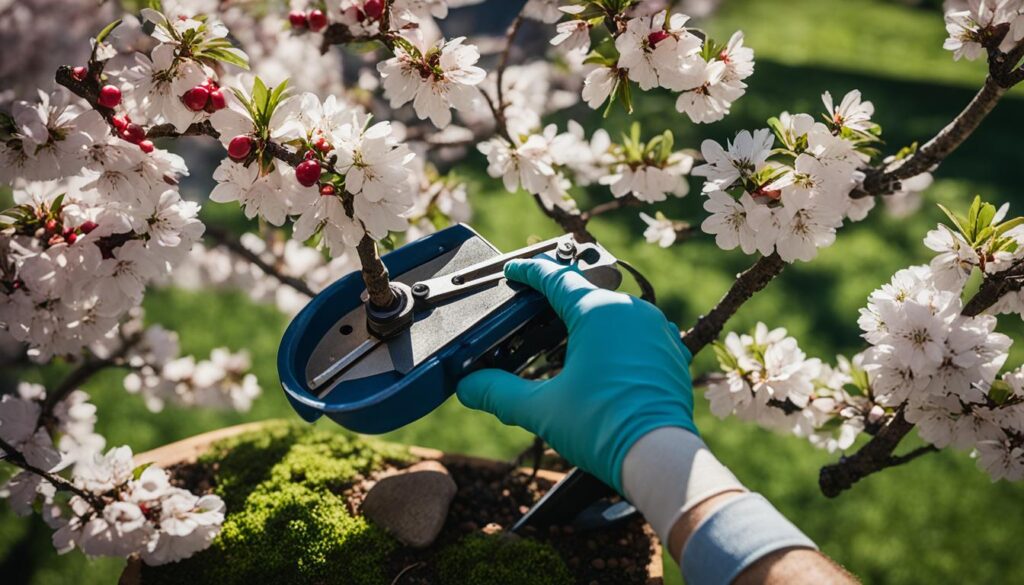
Regular bonsai pruning and shaping are essential for the health and aesthetic of the Cherry Blossom Bonsai. Pruning should be done after the tree has finished blooming, usually in the summer months. Pinch back new shoots to shape and encourage bonsai shaping, and reserve heavier pruning of main branches or stems for the winter months. However, be careful not to remove all new growth, as some should be left to ensure the tree can continue growing. Proper bonsai maintenance techniques are crucial for maintaining the desired shape and promoting the tree’s overall vigor.
| Pruning Technique | Timing | Purpose |
|---|---|---|
| Pinching back new shoots | Summer | Shape and encourage branching |
| Heavier branch/stem pruning | Winter | Maintain desired shape |
| Leaving some new growth | Throughout the year | Ensure continued tree health and vigor |
“Proper pruning is the foundation for creating and maintaining the distinct shape and character of a bonsai tree.”
- Prune after the tree has finished blooming, typically in the summer months.
- Pinch back new shoots to encourage branching and shape the bonsai.
- Reserve heavier pruning of main branches or stems for the winter season.
- Avoid removing all new growth, as some should be left to sustain the tree’s vigor.
- Utilize precise bonsai pruning techniques to preserve the desired aesthetic and promote overall tree health.
Conclusion
In conclusion, the cultivation and care of bonsai tree cherry blossoms, or Sakura Bonsai, require a deep understanding of the plant’s specific needs and a commitment to the art of bonsai. By mastering the techniques of selecting, watering, wiring, repotting, and pruning these miniature trees, you can create and maintain a stunning, living work of art that captures the beauty and cultural significance of the cherry blossom. Whether you are a seasoned bonsai enthusiast or a beginner, the rewarding experience of growing and shaping a thriving Sakura Bonsai is one that will bring joy and a deeper appreciation for this timeless bonsai cultivation practice.
The bonsai tree care for Cherry Blossom Bonsai involves understanding the unique requirements of these delicate trees, from their sunlight and temperature needs to their watering habits and pruning techniques. By providing the right growing conditions and maintaining a careful, attentive approach, you can cultivate a Sakura Bonsai that not only flourishes but also serves as a living embodiment of the Japanese cultural reverence for the cherry blossom.
Whether you are embarking on your first venture into the world of bonsai cultivation or expanding your existing collection, the Sakura Bonsai offers a profoundly rewarding and enriching experience. By nurturing these miniature trees, you can connect with the natural world, honor centuries-old traditions, and create a living, breathing masterpiece that will bring joy and wonder to all who behold it.
